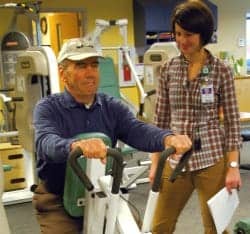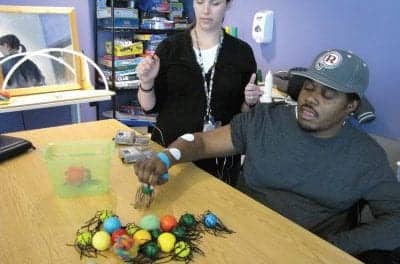 |
| Julie K. Silver, MD, PHD is the coauthor of Life After Stroke. |
Stroke has been indiscriminating and devastating throughout the ages. Money, power, and prestige did not protect Franklin Roosevelt from a fatal hemorrhagic stroke—thereby suddenly ending his presidency and changing the course of World War II. Stalin, rumored to be mentally unbalanced as a young man, and legendary for his unmitigated abuse, had multiple strokes that likely further impaired his ability to be rational. Even former president Gerald Ford could not escape having a stroke, though when he initially presented to the emergency department at Hahnemann University Hospital, doctors mistakenly attributed his symptoms to an inner ear infection. Youth and excellent physical health are not necessarily protective as linebacker Tedy Bruschi found out in February 2005, when he suddenly suffered a stroke just 10 days after he helped lead his team, the New England Patriots, to a Super Bowl victory.
Indeed, stroke is the leading cause of paralysis and the third leading cause of death in developed countries (behind heart disease and cancer, respectively). More than 700,000 strokes occur annually in the United States, and of these, 500,000 are new strokes and 200,000 recurrent disease. There are another 200,000 to 500,000 people who experience transient ischemic attacks (TIAs).
Though the incidence of stroke is impressive, a number of medical interventions have improved the prognosis for many stroke survivors. For example, in 1986 the “clot busting” drug called tissue plasminogen activator, or tPA for short, became available for use in people with ischemic-type strokes. This medication, which can help limit or even reverse the damage of a brain attack, must be given within hours of the onset of symptoms. Unfortunately, some experts estimate that up to 90% of stroke patients who would be candidates for this treatment do not get it due to a variety of factors, including patient delays in seeking care. This happened to Bruschi, who awoke one night with a severe headache and felt numbness in his left arm and leg. Bruschi tried to “tough it out” and went back to sleep. Five hours later, his wife called 9-1-1, and by the time he got to the hospital, it was too late for him to be given tPA. However, for those who do receive this treatment, damage to the brain and subsequent disability can be dramatically altered.
Another factor that can improve the prognosis in stroke survivors is the better imaging studies that have led to an increase in physicians’ ability to identify the cause of a stroke—an important factor in preventing recurrence. For example, Tedy Bruschi’s stroke is believed to have been caused by a small hole in his heart that was later surgically repaired. This treatment intervention enabled Bruschi to return to the National Football League this season.
REHABILITATION AFTER STROKE
 |
Changing the natural history of a stroke in progress with tPA and identifying the underlying causes of stroke in order to prevent recurrence have profoundly improved the prognosis for some stroke patients. New and emerging rehabilitation treatments also are improving the prognosis for some survivors. Joel Stein, MD, the chief medical officer at Spaulding Rehabilitation Hospital in Boston and author of Life After Stroke: The Guide to Recovering Your Health and Preventing Another Stroke,1 says that the most exciting stroke research is working toward “the opportunity to actually improve neurologic recovery.” Stein and his team at Spaulding have worked on numerous research studies, including ones looking at the use of robotic and virtual reality devices to assist with motor recovery through exercises.
Stein works with Spaulding colleagues Richard Hughes and Anat Mirelman, a research coordinator and a research assistant, respectively. Together, they are testing the Rutgers Ankle Rehabilitation System. This device is similar to a video game that is controlled by foot and ankle movement. Mirelman explains, “This is a Stewart platform (6 degrees of freedom) pneumatic device that is connected to a computer that runs two simulations (a plane and a boat). The subject is seated on a chair in front of the computer, and his foot is attached to the platform. He is required to maneuver through a series of targets in the virtual environment without colliding with them. This maneuvering is produced by the subject moving his ankle (dorsiflexion/plantar flexion, eversion/inversion, and a combination), much like using a joystick. The exercise is manipulated by the therapist in terms of resistance, speed, orientation of the targets, duration, and intensity.”
This training is done in 1-hour sessions, three times per week, for 4 weeks. Patients who would easily tire or become bored with more traditional exercise seem to be able to tolerate this “video game” quite well. Mirelman says, “Subjects describe the training as fun, it is highly motivating, and they seem to catch on to it really quickly.” Test participants have been from 1 year to 7 years post-stroke and have varied between 35 and 75 years of age. Those with severe perceptual deficits are excluded from studies.
In pilot studies, the Rutgers Ankle Rehabilitation System has shown improvements in functional walking in terms of speed of gait, increased endurance, and improved ability to negotiate stairs.2,3 Mirelman says that in a pilot study done recently by her team, they found that functional improvements were closely related to increases in force generation (as seen by kinetic and kinematic changes) and coordination of movement.4 Further studies are pending, and currently this device is used primarily for research purposes, though in the future, a form of it may be used in clinical settings to facilitate motor recovery in stroke patients.
HIGH-TECH RESEARCH
Another high-tech poststroke rehabilitation device that the team is testing is the Interactive Motion Technologies (IMT) robot. Hughes describes this device: “The IMT robot assists and guides arm movements/reaching to provide movement therapy for people who have neurological disease. We have studied primarily persons after stroke, but currently we are also investigating how well the robot works to promote improved arm function in children with cerebral palsy. People using the robot watch a computer screen, and move the robotic arm to ‘hit targets’ on the screen, like the joystick on a computer game.” So far, the research has shown “modest improvements” in reaching ability for stroke survivors.5-7
The IMT robot is believed to help facilitate motor recovery by repetitive practice and task-oriented movements that stimulate neural plasticity. Hughes says, “It also provides an effective structure for exercise-people using the robot find that they can perform hundreds of repetitions each session, and they don’t find it boring. The virtual reality folks call this an ‘immersive’ effect.” Members of the research team believe that the “error-free” motor learning approach, in which subjects are successful in hitting the targets with robotic assistance, is critical. To date, the IMT robot is used for research, though similar to the Rutgers Ankle Rehabilitation System, future models may be used clinically.
High-tech research is only part of what is happening in the stroke medical community. Other types of research also are ongoing—including new drugs that may help prevent or treat strokes. Examples include growth factors that are naturally produced by the body and instruct cells to grow and multiply. Stem cells are also a possible future treatment for stroke patients. Constraint-induced movement therapy is a technique in which a stroke survivor’s unaffected arm is placed in a restraining sling for up to 6 hours per day for a 2-week period, preventing them from using it and forcing the weak arm to exercise. Preliminary studies suggest that this helps to increase the functional use of the affected arm. Partial weight-supported treadmill training also is being studied. In this technique, the stroke survivor is placed in a supportive harness to reduce the amount of weight needed to support the legs. They then use a treadmill to practice walking. This type of exercise shows promise and is being further investigated; however, it is time-intensive and requires the assistance of two physical therapists.
FUNCTIONAL EXERCISE FOR STROKE SURVIVORS
Although many fascinating and hopeful studies are being done to help stroke survivors, the mainstay of stroke rehabilitation continues to be functional exercise, improving mobility with appropriate assistive devices, occupational therapy to promote independence with activities of daily living, and speech therapy to help with swallowing and language issues. Cognitive retraining and adaptive strategies for problems with memory and concentration are also part of stroke rehabilitation. In addition to these interventions, the stroke team needs to address common poststroke complications such as urinary incontinence, sexual dysfunction, depression, and the prevention and treatment of deep vein thrombosis and decubitus ulcers.
In the book Life After Stroke, Stein and his coauthors discuss in detail the lifestyle changes that people can make to help prevent stroke recurrence. These changes include improving diet and exercise regimens, limiting alcohol intake, and discontinuing smoking and use of any illicit drugs. Stroke survivors can work with their doctors to improve chronic health conditions such as high blood pressure and diabetes, which can contribute to stroke risk. Stein notes that paramount to the rehabilitation effort is working with stroke patients and their families to “help them understand the impact of stroke and help prevent another stroke.”
Julie K. Silver, MD, PhD, is medical director, Spaulding-Framingham Outpatient Center, Framingham, Mass; assistant professor at Harvard Medical School; and founder of Restore, a multidisciplinary rehabilitation program for cancer survivors. Silver, who serves as an advisor on the editorial board of Rehab Management, is author of more than a dozen books focusing on recovery from serious illnesses and injuries. She can be reached at .
REFERENCES
- Stein J, Silver J, Frates EP. Life After Stroke: The Guide to Recovering Your Health and Preventing Another Stroke. Baltimore: Johns Hopkins University Press; 2006.
- Deutsch JE, Merians AS, Adamovich S, Poizner H, Burdea GC. Development and application of virtual reality technology to improve hand use and gait of individuals post-stroke. Restor Neurol Neurosci. 2002;20:1-16.
- Deutsch JE, Paserchia C, Vecchione C, et al. Improved gait and elevation speed of individuals post-stroke after lower extremity training in virtual environments. JNPT. 2004;28:185-186.
- The pilot study results are under review and have not been published yet, but have been reported in the International Workshop on Virtual Reality (August 2006).
- Stein J, Krebs HI, Frontera WR, Fasoli SE, Hughes R, Hogan N. Comparison of two techniques of robot-aided upper limb exercise training after stroke. Am J Phys Med Rehabil. 2004;83:720-8.
- Fasoli SE, Krebs HI, Stein J, Frontera WR, Hogan N. Effects of robotic therapy on motor impairment and recovery in chronic stroke. Arch Phys Med Rehabil. 2003;84:477-82.
- Krebs HI, Ferraro M, Buerger SP, et al. Rehabilitation robotics: pilot trial of a spatial extension for MIT-Manus. J Neuroengineering Rehabil. 2004;26:1:5.





